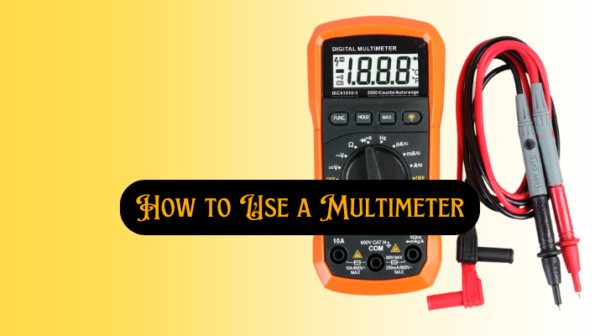A multimeter is a useful instrument for measuring electrical qualities such as resistance, voltage, and current. This useful device is ideal for both experts and do-it-yourselfers, combining the functions of an ohmmeter, ammeter, and voltmeter. When working on electrical tasks around the house or doing maintenance on electronic equipment, a multimeter can help you stay safe and accurate. In this article, we will guide you on How to Use a Multimeter: A Comprehensive Guide for Beginners.

Key Features
When choosing a multimeter, it’s important to understand the key features that can affect its performance and usability. Here are some of the most crucial aspects to consider:
- Digital vs. Analog: Digital multimeters display readings on a screen, offering greater precision and ease of use than their analog counterparts, which use a needle to indicate values.
- Auto-Ranging: This feature allows the multimeter to automatically select the correct range for the measurement being taken, making it easier for beginners to use.
- Data Hold Function: A useful feature that lets you freeze the display reading, allowing you to record the measurement even after removing the multimeter from the circuit.
- Backlit Display: A backlit screen enhances visibility in low-light conditions, ensuring accurate readings regardless of your environment.
Pros and Cons
Like any tool, a multimeter has its advantages and drawbacks. Understanding these can help you make an informed decision when choosing the right one for your needs.
Pros
- Versatility: A multimeter can measure multiple electrical properties, reducing the need for multiple tools.
- Accuracy: Modern digital multimeters provide highly accurate readings, essential for precise work.
- Portability: Compact and lightweight, a multimeter is easy to carry around on the job or in your toolbox.
- Safety Features: Many multimeters come with protective features such as overload protection and insulated probes, reducing the risk of accidents.
Cons
- Learning Curve: For beginners, understanding how to use a multimeter can be challenging due to its various functions and settings.
- Cost: High-quality multimeters can be expensive, though they are a worthwhile investment for those who frequently work with electronics.
- Complexity: Some advanced features may be overwhelming for novice users, making simpler models more suitable for beginners.
How to Use a Multimeter
Learning how to use a multimeter effectively is crucial for ensuring accurate measurements and safe operation. Here’s a step-by-step guide to help you get started:
1. Safety First
Before using a multimeter, always ensure that you follow basic safety protocols. Wear protective gear, avoid wet conditions, and never touch exposed wires or circuits with your bare hands.
2. Set the Multimeter to the Correct Measurement Mode
- Voltage (V): Use this setting to measure the voltage in a circuit. Choose AC or DC depending on the type of current you’re measuring.
- Current (A): This setting is for measuring the current flowing through a circuit. Be sure to connect the multimeter in series with the circuit.
- Resistance (Ω): Use this mode to measure the resistance within a circuit or component. The multimeter should be connected in parallel to the component.
3. Connect the Probes
Insert the black probe into the COM (common) jack and the red probe into the appropriate jack based on what you’re measuring (e.g., VΩ for voltage/resistance or A for current).
4. Take the Measurement
- For voltage or resistance measurements, connect the probes across the component or circuit.
- For current measurements, break the circuit and connect the multimeter in series.
- Read the value on the digital multimeter display.
5. Interpret the Results
Understand the units and ranges displayed on the multimeter. For example, “mV” indicates millivolts, and “kΩ” indicates kilohms.
Types of Multimeters
Multimeters come in various types, each suited for different applications. Here are the main categories:
1. Digital Multimeters (DMMs)
These are the most common types and are favored for their accuracy and ease of use. Digital multimeters are ideal for beginners due to their clear digital displays and advanced features like auto-ranging.
2. Analog Multimeters
Analog multimeters use a needle to indicate measurements on a scale. While less common today, they are still preferred by some professionals for detecting trends and subtle changes in readings.
3. Clamp Multimeters
These specialized multimeters are designed to measure current without breaking the circuit. They feature a clamp that can be placed around a conductor to measure the current flow.
How to Choose the Best Multimeter
Selecting the best multimeter depends on your specific needs and experience level. Here are some factors to consider:
1. Determine Your Needs
Consider what you will primarily use the multimeter for. If you’re working on home electrical systems, a basic digital model may suffice. For more advanced electronics work, you might need a multimeter with higher precision and additional features.
2. Check the Specifications
Look for a multimeter with a high enough range for the measurements you’ll be taking. Accuracy is key, so check the resolution and sensitivity of the device.
3. Evaluate the Build Quality
Please make sure the multimeter is durable and well-constructed. It should have insulated probes, a robust casing, and reliable safety features.
4. Consider the Brand and Warranty
Reputable brands often provide better customer support and warranty coverage. Investing in a quality multimeter from a trusted brand can save you money and hassle in the long run.
Conclusion
A multimeter is an essential tool for anyone working with electrical systems, offering versatility, precision, and safety. By understanding the key features, types, and proper usage of a multimeter, beginners can confidently perform a wide range of measurements. When choosing the best multimeter for your needs, consider your specific requirements, the device’s specifications, and its overall build quality. With the right multimeter in hand, you’ll be well-equipped to tackle any electrical task with accuracy and safety.